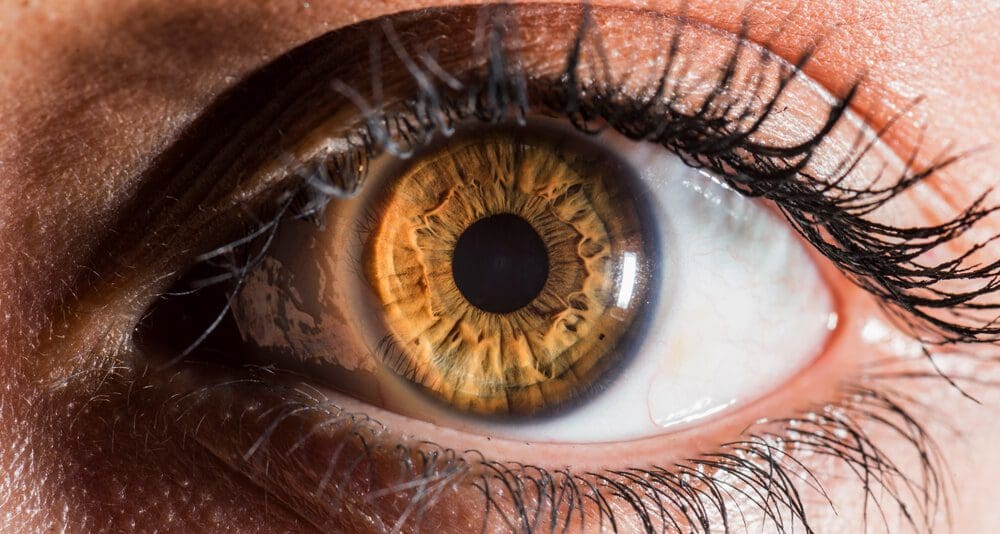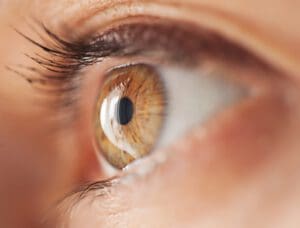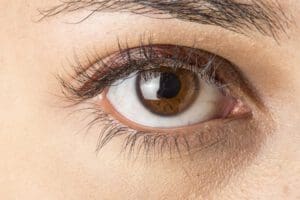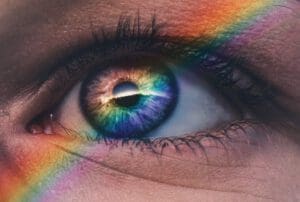How Do You Know if Your Eyes Are Green or Hazel?
Throughout the globe, 79 percent of people have brown eyes and five percent have hazel eyes. These two colors are ofttimes considered the same color, simply they are 2 singled-out hues.
The iris of your eye is the part that has color. In that location are genes that work to decide whether your eyes are brown, hazel, or another color.
Both dark-brown and hazel eyes are in the dark-brown family. But hazel eyes feature other colors in addition to brown.
Pigmentation plays a major office in whether you have chocolate-brown or hazel eyes. Melanin also determines how dark your eyes become.
Both of these eye colors come up with their benefits. For example, if yous take dark-brown eyes, you tend to have a lower chance of macular degeneration.
How Practise Brown and Hazel Eyes Occur?

The iris is the colored part of your middle, equally it contains pigmentation. There are three primary genes that are responsible for eye color. These genes are inherited from your parents.
The genes associated with eye color largely piece of work in the transport, storage, and production of melanin — the pigment that results in eye color. 2 of the common genes are HERC2 and OCA2.
A substance called a P protein works to mature melanosomes. These are a type of cellular structure that piece of work to shop and produce melanin. The OCA2 factor produces this poly peptide. Since chocolate-brown eyes accept a lot of melanin, they have higher levels of P poly peptide.
HERC2 has a region referred to equally intron 86. Within this region is a DNA segment that controls OCA2 gene activity. HERC2 essentially turns the OCA2 gene off or on when it is necessary. With higher OCA2 activity, your optics will be darker.
While these two genes are the ones that are primarily responsible for middle color, they are not the merely genes that play a role. It is believed that other genes play a bottom office in eye colour by combining with HERC2 and OCA2 to produce a variety of eye colors.
In many cases, you tin predict a child'south eye color based on their parents. However, there are sure genetic variations that brand some results unpredictable.
How Are They Like and Different?

Brownish and hazel optics are often put into the same category. In certain types of light, especially low light, hazel eyes can appear to be light dark-brown.
Even so, hazel optics are far more than diverse compared to brown eyes. When optics are hazel, they are brown mixed with amber and green. In some cases, there are shades of greyness, blue, and golden within the iris too.
Brown eyes may also have some green in them. Nonetheless, it is not nearly as noticeable as it is when someone has hazel eyes.
With brown and hazel eyes, the other colors may announced every bit rings or flecks of color. This is role of what makes these eyes so distinctive. Due to the differences, no fix of chocolate-brown or hazel eyes is like those of some other person.
What Are the Unique Characteristics of Brown and Hazel Eyes?

The pigmentation and melanin levels of these center colors are unique compared to other heart colors. The more than melanin in the iris of your eyes, the darker they are.
Both hazel and brown eyes have a normal level of melanin presence at the back layer. At the front end layer, brownish eyes accept a heavy melanin presence. At this layer with hazel eyes, the presence of greenish is higher than the presence of brownish.
The paint eumelanin is a dominant pigment in both hazel and brown optics. Hazel eyes also have another dominant pigment known equally pheomelanin.
Myths Virtually Brown and Hazel Eyes
It was in one case believed that one gene determined a person's center colour. It turns out that there could be up to 16 genes responsible for this.
Because there are so many genes at play, parents tin accept children with an centre colour that neither of them have.
Pros and Cons of Each Center Color
 Brown optics are associated with increased and decreased risks of certain eye problems. When people have brown eyes, they tend to exist at a lower risk for macular degeneration, heart cancer, and diabetic retinopathy. While the reason why is unclear, information technology is believed that this is due to dark-brown eyes having greater protection due to a college level of melanin.
Brown optics are associated with increased and decreased risks of certain eye problems. When people have brown eyes, they tend to exist at a lower risk for macular degeneration, heart cancer, and diabetic retinopathy. While the reason why is unclear, information technology is believed that this is due to dark-brown eyes having greater protection due to a college level of melanin.
Another possible benefit of hazel or brown eyes is that you may exist less prone to impairment from environmental noise. Information technology is believed that the college level of melanin may offering protective benefits for the brain'southward fretfulness that may experience damage due to noise.
On the other side, brown eyes may exist at a higher risk for developing cataracts. One study plant that the take a chance may be twice as high as people with other eye colors. Exactly why this happens was not explored by the written report.
Brown and hazel eyes have a variety of distinct characteristics that make them desirable colors.
References
The World'southward Population by Eye Colour Percentages. World Atlas.
Why Are Chocolate-brown Eyes the Most Common? (August 2017). American Academy of Ophthalmology.
Genotype-Phenotype Associations and Man Middle Color. (October 2010). Journal of Human Genetics.
Iris Color and Cataract: The Blue Mountains Center Study. (August 2000). American Periodical of Ophthalmology.
Eye Color Linked to Hurting Tolerance in Pilot Study at Pitt. (July 2014). Pittsburgh Mail-Gazette.
Is Eye Color Determined by Genetics? (May 2015). Genetics Home Reference.
The information provided on this page should non be used in place of information provided past a doctor or specialist. To acquire more, read our Privacy Policy and Editorial Policy pages.
Source: https://www.nvisioncenters.com/education/brown-vs-hazel-eyes/
0 Response to "How Do You Know if Your Eyes Are Green or Hazel?"
Post a Comment